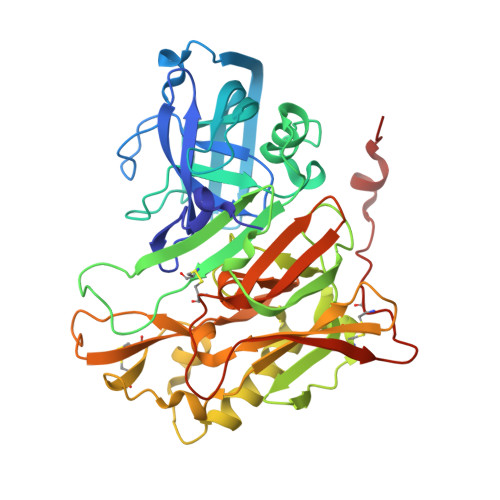Spirocyclic beta-site amyloid precursor protein cleaving enzyme 1 (BACE1) inhibitors: from hit to lowering of cerebrospinal fluid (CSF) amyloid beta in a higher species.
Hunt, K.W., Cook, A.W., Watts, R.J., Clark, C.T., Vigers, G., Smith, D., Metcalf, A.T., Gunawardana, I.W., Burkard, M., Cox, A.A., Geck Do, M.K., Dutcher, D., Thomas, A.A., Rana, S., Kallan, N.C., DeLisle, R.K., Rizzi, J.P., Regal, K., Sammond, D., Groneberg, R., Siu, M., Purkey, H., Lyssikatos, J.P., Marlow, A., Liu, X., Tang, T.P.(2013) J Med Chem 56: 3379-3403
- PubMed: 23537249
- DOI: https://doi.org/10.1021/jm4002154
- Primary Citation of Related Structures:
4JOO, 4JP9, 4JPC, 4JPE - PubMed Abstract:
A hallmark of Alzheimer's disease is the brain deposition of amyloid beta (Aβ), a peptide of 36-43 amino acids that is likely a primary driver of neurodegeneration. Aβ is produced by the sequential cleavage of APP by BACE1 and γ-secretase; therefore, inhibition of BACE1 represents an attractive therapeutic target to slow or prevent Alzheimer's disease. Herein we describe BACE1 inhibitors with limited molecular flexibility and molecular weight that decrease CSF Aβ in vivo, despite efflux. Starting with spirocycle 1a, we explore structure-activity relationships of core changes, P3 moieties, and Asp binding functional groups in order to optimize BACE1 affinity, cathepsin D selectivity, and blood-brain barrier (BBB) penetration. Using wild type guinea pig and rat, we demonstrate a PK/PD relationship between free drug concentrations in the brain and CSF Aβ lowering. Optimization of brain exposure led to the discovery of (R)-50 which reduced CSF Aβ in rodents and in monkey.
- Array BioPharma, 3200 Walnut Street, Boulder, CO 80301, USA. hunt@arraybiopharma.com
Organizational Affiliation:


















